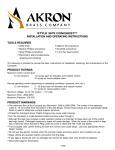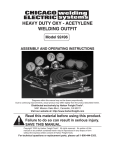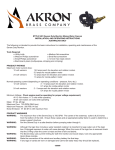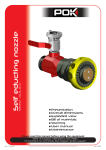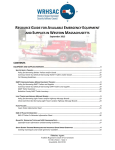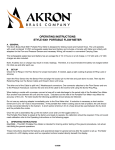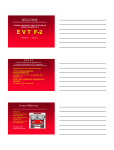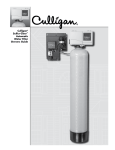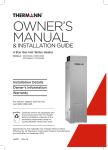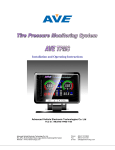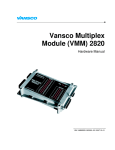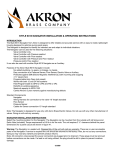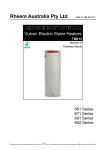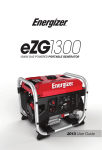Download AKRON EDUCTORS TROUBLESHOOTING GUIDE
Transcript
AKRON EDUCTORS TROUBLESHOOTING GUIDE OPERATION & THEORY OF EDUCTORS GENERAL OPERATING AND MAINTENANCE INSTRUCTIONS Pertains to all Akron Bass Eductors: • • • • • Akron Eductors are designed for use with all Class A and B foam concentrates. Both portable and truck eductors have metering capability from 0 – 6% with detent stops at 1/4% – 1/2% – 1% – 3% and 6%. Metering between these detents can be achieved. Standard inlet operating pressure is 200 psi on all eductors (1400 kPa/14 bar). Recommended nozzles to use are any Akron constant flow types rated at 75 or 100 psi (500 kPa/5 bar or 700 kPa/7 bar). Nozzle flow rate must equal eductor flow rate. Hose lay lengths and nozzle elevations are displayed in TABLE I and TABLE II. GENERAL INSTRUCTIONS – FOR AKRON EDUCTORS (Includes in-line, by-pass and built-in types of any flow size) 1. Hose lay limits past the eductor must not be exceeded. 2. 200 psi must be maintained at the eductor inlet to obtain the proper mixture. 3. The nozzle and eductor must be rated at the same flow for maximum performance. However, in all cases, the nozzle flow setting must not be less than the eductor. 4. The nozzle must be fully open. A throttled nozzle can cause the system to shut down. 5. Always flush both the eductor and nozzle thoroughly, for at least 3 minutes, after each use. WARNING: Since various foam concentrates have different viscosities, they do not proportion the same. It may be necessary to dial up to achieve proper proportioning. In no case would you dial down. Older eductors have a pick up tube strainer screen. Removal of the screen will assist with the pick up rate. However, be sure to use the castellated retainer if the screen is removed. OPERATING INSTRUCTIONS – BYPASS EDUCTORS 1. For water – turn the valve handle to the “water” position and operate the pump pressure in a normal manner (usually about 100 psi (700 kPa/7 bar) plus the estimated friction loss in the hose). 2. For foam – turn the valve handle to “foam” position and increase the inlet pressure to the eductor to 200 psi (1400 kPa/14 bar). 3. To return to water from foam – first reduce the pump pressure to 100 PSI (700 kPa/7 bar)then turn the valve handle to the “water” position. 4. All other operating instructions for inline and bypass eductors also apply. 110193 MAINTENANCE INSTRUCTIONS – INLINE AND BYPASS EDUCTORS Occasionally remove the metering head to ensure that the check ball is free to move. This can be accomplished as follows: 1. Attach the eductor to the outlet of a truck discharge. 2. Attach a nozzle which is matched to the flow of the eductor to the eductor outlet. 3. Remove the metering head, by rotating knurled swivel collar. 4. Flow water with the nozzle fully open. The ball should be clear of the hole under the metering head and suction should be felt if a finger is placed over this hole. 5. While flowing, partially close the nozzle until the check ball pops out and closes the opening. Open the nozzle to allow ball to uncheck. AKRON EDUCTORS AND 75 PSI NOZZLES (500 kPa/5 bar) A significant advantage is gained using Akron high performance 75 psi (500 kPa/5 bar) rated nozzles with the new Akron 3000 series eductors. Due to superb nozzle performance with these nozzles, up to 60% increase in hose lay is possible. Nozzles to consider for this added advantage are the ASSAULT™ and TURBOJET® lines designed for 75 psi (500 kPa/5 bar). The addition of the QUICK ATTACK foam tube for these nozzles can result in foam expansion up to 14-1. TROUBLESHOOTING EDUCTORS There are many factors which influence the operation of a foam system, only one of which is the eductor itself. The following is designed to help the user determine which element of the system is at fault when the system is not functioning properly. 1. The first area to check is the inlet pressure. All Akron inline and bypass eductors are designed to operate with 200 psi (1400 kPa/14 bar) at the inlet of the eductor. These eductors will inject the additive at pressures substantially less than 200 psi (1400 kPa/14 bar), but the metering is calibrated for this pressure. If the unit is operated at lower pressures, the mix will have higher percentage of additive than that shown on the metering dial. Also after the pressure drop in the unit, there must be sufficient residual pressure to properly operate a fog nozzle or foam tube. These nozzles are designed to operate at 75 or 100 psi (500-700 kPa/5-7 bar) nozzle pressure. Therefore, if the eductor inlet pressure is reduced, the nozzle may not function properly. 2. The next item to check is the suction on the pick-up tube. All Akron eductors are built with a unique check ball in the eductor where the pick-up tube, or foam line is connected to the body. Unscrew the knurled ring which secures this tube, and flow water through the eductor. If the unit is a bypass or truck eductor, ensure that it is in the foam setting. If the unit is functioning, the ball will “pop” in and suction can be felt when a finger or thumb is placed over the opening. If the suction is present, but the system will not produce foam, check that the pickup tube is not blocked and will allow the passage of the concentrate. With a built-in truck eductor, ensure that the concentrate can reach the eductor when the foam control is activated, and check for air leaks in the piping of the additive to the eductor. The maximum recommended lift between the foam level and the eductor is six (6) feet. 3. The third area to check is the nozzle or discharge. The nozzle must be matched to the eductor. A 60 GPM (230 LPM) nozzle must be used with a 60 GPM (230 LPM) eductor. Similarly, a 95 GPM (360 LPM) eductor requires a 95 GPM (360 LPM) nozzle, a 125 GPM (475 LPM) eductor requires a 125 GPM (475 LPM) nozzle and a 250 GPM (950 LPM) eductor requires a 250 GPM (950 LPM) nozzle. A simple test of whether the nozzle is at fault is to remove the hose from the discharge side of the eductor or the truck outlet. If an inline or bypass eductor is used, secure the eductor to maintain control of it and flow water. If suction can be felt at the check ball or additive can be seen in the discharge stream, the nozzle is at fault or there is too much hose between the eductor and the nozzle. 4. If the eductor functions properly without the hose attached, install the nozzle directly on the outlet of the eductor. Operate the unit again. If the eductor does not function properly, the nozzle is at fault. Check that the nozzle has the proper rated capacity and that there is no debris in the nozzle. 5. If the eductor works properly with the nozzle directly on the outlet, the problem is probably in the hose. Check that the hose lay does not exceed the maximum listed in the operating instructions. Check that there is no blockage in the hose, especially at the couplings. 6. If there is no apparent problem with the hose and the nozzle is manufactured by another company, the problem may be with the nozzle. Some competitive nozzles do not flow their rated gallonage. Test the system with an Akron Turbojet®, Assault™ or Marauder® set at the proper gallonage. All Akron nozzles flow at least the rated gallonage to ensure proper operation in a foam system. 7. If there is still no suction at the check ball with the correct inlet pressure and nothing connected to the outlet, the eductor will have to be returned to Akron Brass for repair. 8. If the foam does not have the proper consistency, the metering calibration may be at fault. First check that the gallonage stamped in the center of the metering dial (60, 95, 125 or 250) (230, 360, 475 or 950 LPM) is the same as the gallonage stamped on the body. Set the metering dial at 3% and fill a one (1) gallon pail with water. Once the water is flowing through the eductor at 200 psi (1400 kPa/14 bar) inlet pressure, put the pickup tube into the pail of water and record the time that is required to empty the pail. A 60 GPM (230 LPM) eductor should empty the pail in 33 seconds. Similarly, the 95 GPM (360 LPM) unit should take about 21 seconds, the 125 GPM (475 LPM) unit about 19 seconds and the 250 GPM (950 LPM) unit should take about 11 seconds. OPERATION AND THEORY OF EDUCTORS The following is an explanation of how eductors work based on a number of frequently asked questions about eductor and nozzle systems. The theories apply to all types of eductors, but unless noted otherwise, numbers refer specifically to Akron eductors. What is an eductor? The NFPA definition is “a device placed in a hose line to proportion liquid foam or wetting agent into the fire stream”. How does an eductor work? An eductor utilizes the energy in the form of pressure, which is in the water stream, to create a low pressure area and, thereby, induct and mix the concentrate into the stream. The venturi near the inlet of the eductor increases the velocity of the water. The venturi is just like a very efficient solid bore tip. The water passes into the induction chamber, which has a larger area than the orifice of the venturi, thereby creating a low pressure area. A separate orifice, or series of orifices, ntrols the flow of concentrate into the low pressure area. The rest of the eductor is designed to recover as much of the inlet pressure as possible. What is a bypass eductor? A bypass eductor has two separate flow paths. One side of the bypass eductor is exactly the same as a standard inline eductor. The other side is a straight through flow path, without the friction loss of an eductor. This device can be used in a hose line in the bypass mode for flowing water. (Be sure foam supply is off when using bypass or foam may be educted, since eductor line is open). When foam is required, the bypass valve can be changed to force the flow of water through the eductor. What inlet pressure is required? All eductors are calibrated for a specific inlet pressure. Akron eductors are calibrated for 200 psi (1400 kPa/14 bar). At this pressure, the output of the eductor will be the rated flow. The amount of concentrate entering the induction chamber is determined by percentages shown on the metering dial. Since the eductor is flowing its rated flow, the corresponding nozzle will operate near *100 psi (700 kPa/7bar). (If it is 100 psi (700 kPa/7bar) rated nozzle and 6% is selected) Lower percentages will lower nozzle pressure. An eductor system, which includes the eductor, no more than the maximum hose lay for that eductor, and a matched single gallonage nozzle, will work at a wide range of inlet pressures. The eductor in this system will work with an inlet pressure of 50 psi (350 kPa/3.5 bar) to 200 psi (1400kPa/14 bar). However, the venturi of the eductor is just like a solid bore nozzle, so the flow varies as the square root of the pressure. As the flow out of the eductor decreases, the nozzle pressure will also decrease, and this affects the reach from the nozzle. Whenever this type of system will be used at lower inlet pressures, tests should be conducted to determine that the performance of the nozzle is satisfactory. The flow of concentrate into the induction chamber is controlled by the orifices in the metering head. The inlet pressure to these orifices is atmospheric pressure. This does not change as the pressure into the eductor changes, so the flow of concentrate remains the same. Since the flow of water will decrease at lower inlet pressures, but the flow of concentrate remains the same, the resulting percentage of the foam solution will be higher. *NOTE: 100 psi (700 kPa/7bar)is used as reference only. An NFPA 1964 compliant nozzle could flow 10% higher GPM (LPM) at 100 psi (700 kPa/7bar)causing nozzle pressure to drop. How much water will an eductor flow? The rated flow of an eductor includes the water flow plus the flow of concentrate at the maximum pickup rate. Akron eductors are sized for a maximum 6% pickup rate. Since the flow of water through the eductor remains the same at the different percentage pickup rates, but the amount of concentrate will change at different percentage settings, the total flow out of the eductor will also vary slightly with these different rates. An Akron 60 GPM (230 LPM) eductor flows 57 GPM (215 LPM) of water. A 95 GPM (360 LPM) eductor flows 88 GPM (333 LPM) of water. The 125 GPM (475 LPM) eductor flows 116 GPM (439 LPM) of water. The 250 GPM (950 LPM) eductor flows 232 GPM (878 LPM) of water. What types of nozzles will work with eductors? Eductors will work with virtually any nozzle that is sized to the eductors. Eductors will even work with no nozzle on the end of the hose, or no hose attached. The choice of nozzles should depend on the type of foam and the preferred method of application. Non-aspirating water fog nozzles or air aspirated nozzles can be used with AFFF and detergent type foams. These types of foam having foaming ingredients that continue to work after the solution leaves the nozzle. Protein and fluroprotein foams require mechanical aspiration and should only be used with an air aspirating nozzle. Alcohol and polar solvent type foams should be air aspirated when used on that type of fire (use foam manufacturers recommended percentage). Air aspirating foam nozzles will normally produce a foam with a higher expansion ratio and significantly longer drain time than water fog nozzles. The reach of the stream is normally less than that with a water fog nozzle. How efficient is an eductor? An eductor uses energy in the form of inlet pressure to create the necessary low pressure area and impart velocity to the incoming concentrate. This requires about 30% of the inlet pressure, so that the maximum pressure at the outlet of an eductor cannot exceed 70% of the inlet pressure without affecting the performance of the eductor. There is no such thing as standard efficiency of an eductor. The outlet pressure will depend on how much pressure is required to push the foam solution through the hose and out the nozzle. The eductor automatically balances the system. A 95 GPM (360 LPM) eductor with 200 psi (1400 kPa/14 bar) at the inlet will flow 88 GPM (333 LPM) of water. If this eductor is mounted on the side of a truck with a line gauge at the outlet and no nozzle, the eductor will still flow 88 GPM (333 LPM) and the line gauge will read about 2 psi (14 kPa/.14 bar). The pressure loss across the eductor is 198 psi (1365 kPa/13.6 bar), giving an efficiency of about 1/2%. If a GPM (LPM) nozzle is attached to the line gauge, and the eductor run at the same inlet pressure, the gauge will read about 88 psi (606 kPa/6 bar) (it requires about 88 psi (606 kPa/6 bar) to flow 88 GPM (333 LPM) through a 95 GPM (360 LPM) nozzle). The eductor now appears to be about 44% efficient. If the metering head is set at 6% and the pickup tube placed in a pail of water, the line gauge will increase to near *100 psi (700 kPa/7 bar), since the total flow out of the eductor has increased to about 95 GPM (360 LPM). The efficiency now appears to be about 50%. * NOTE: 100 psi (700 kPa/7 bar) is used as reference only. An NFPA 1964 compliant nozzle could flow 105 GPM (398 LPM) @ 100 psi (700 kPa/7 bar) causing nozzle pressure to drop to around 85 psi (586 kPa/5.86 bar). If a length of hose and a second line gauge are added between the line gauge at the outlet of the eductor and the nozzle, and this test repeated, the gauge at the inlet to the nozzle will be the same as in the previous test, but the gauge at the outlet of the eductor will now have increased by the amount of friction loss in the hose. The eductor has automatically balanced the system by increasing the pressure at the outlet of the eductor. This process can continue until the maxi mum efficiency of the eductor has been reached. If additional hose is added while picking up water at 6%, the eductor will pick up less fluid in order to have enough outlet pressure to balance the system. As the pickup is reduced, the nozzle pressure will drop somewhat, since the total flow out of the eductor has been reduced. The gauge at the outlet of the eductor will read the nozzle pressure plus friction loss in the hose, even though that is greater than 70% of the inlet pressure. As long as the eductor is used with a properly sized nozzle, and no more than the length of hose recommended by the manufacturer, there is no need to consider the efficiency of the eductor. It will automatically balance the system and function properly. How much hose can be used with an eductor? The maximum hose lay is determined by the difference between the nozzle pressure and the maximum pressure which can be recovered by the eductor. The maximum hose lay with Akron eductors is shown in Tables I and II. Hose lays of less than the maximum will not affect the operation of the eductor or nozzle. What effect does elevation have? All of the previous discussions assumed that the nozzle and eductor were at the same elevation. No allowance was made for pressure loss due to increasing elevation. If the nozzle is higher than the eductor, the eductor will have to have a higher outlet pressure to overcome the elevation loss plus friction loss, and create nozzle pressure. If the nozzle plus hose lay require that the eductor work at its maximum efficiency without the effect of elevation, and the nozzle is then taken significantly higher than the eductor, the pickup rate will probably be reduced or the eductor will stop functioning properly. This situation may be overcome by reducing the length of the hose or reducing the nozzle pressure. Increasing the pressure at the inlet of the eductor will not overcome this problem, since the eductor will flow more water and, therefore, the nozzle pressure will also increase. Eductors are available which compensate for elevation of the nozzle by sensing the back pressure and automatically reducing the flow through the eductor. This reduces the nozzle pressure, so that extra pressure is available to overcome the head loss. It is important to be cautious when using these eductors, since there will be less foam solution available for firefighting when the nozzle is elevated, and this flow will reduce further as the elevation is increased. One solution to overcoming this problem is to use a multiple gallonage nozzle, such as the Turbojet®. If a 95 GPM (360 LPM) eductor is used with this nozzle and 150 ft. (45 M) of 1-1/2” (38 mm) hose, the system will continue to work when the nozzle is elevated, providing the nozzle setting is changed to 125 GPM (475 LPM) . The nozzle may be raised 80 ft.(25 M) above the eductor and the system will continue to work, although the nozzle pressure will be reduced, and the reach will be affected. The benefit of this over the eductor which automatically reduces flow is that there will still be 95 GPM (360 LPM) of foam solution, even with the added elevation. What sizes of nozzles will work with an eductor? The above discussion of maximum hose lays assumes that the nozzle pressure will be 100 (700 kPa/7 bar) or 75 psi (517 kPa/5.2 bar). Any nozzle that flows the rated flow of the eductor at 100 (700 kPa/7 bar) or 75 psi (517 kPa/5.2 bar) will work within the above guidelines. If the nozzle requires a pressure higher than 100 psi (700 kPa/7 bar) to flow the rated flow of the eductor, the eductor may continue to work providing the nozzle pressure plus friction loss in the hose does not exceed the maximum pressure that the eductor can make available at the outlet and still function properly. If the pressure required to flow the rated flow of the eductor through the nozzle is less than 100 psi (700 kPa/7 bar), the eductor will continue to function and the output from the eductor will remain the same, but the reduced nozzle pressure may affect reach. In this situation, extra hose may be added between the nozzle and the eductor. For example, if a 95 GPM (360 LPM) eductor is used with a 125 GPM (475 LPM) nozzle, the nozzle pressure will be about 60 psi (413 kPa/4.2 bar). The reach from this nozzle will be less than from the same nozzle set at 95 GPM (360 LPM). However, an additional 100 ft. (30 M) of 1-1/2” (38 mm) hose may be added between the nozzle and eductor without affecting the performance of the eductor. Will eductors work with most types of foam concentrates? Akron eductors will work with most foam concentrates and viscosities at ambient temperatures near 70° F. The unique orifice design of the metering head allows the eductor to maintain accurate foam pick up rate required by NFPA 1901 at the various dial settings. Will eductors work with automatic nozzles? As far as the eductor is concerned, it makes no difference what is on the hose, providing the nozzle pressure plus friction loss in the hose plus head loss due to elevation does not exceed the maximum pressure which the eductor can produce and continue to educt. As long as the particular automatic nozzle being used does not require more than 100 psi (700 kPa/7 bar) to flow the rated flow of the eductor, the system will operate properly with 200 psi (1400 kPa/14 bar) at the inlet of the inductor and no more than the maximum hose lays listed previously. Automatic nozzles can create problems if an attempt is made to operate the eductor at a lower inlet pressure, or if the nozzleman is trained to throttle the nozzle. A lower inlet pressure to the eductor will create a lower flow through the nozzle. With a conventional nozzle, this will lower the nozzle pressure, so that the same length of hose will still be acceptable. An automatic nozzle tries to adjust the orifice and maintain approximately 100 psi (700 kPa/7 bar) nozzle pressure. This means that the maximum hose lay must be decreased. Of course, this reduced flow will also increase the percentage of the foam solution and, in effect, waste foam concentrate. When using an automatic nozzle with an eductor, the nozzle should never be throttled. Throttling the nozzle increases the pressure at the inlet to the nozzle by reducing the size of the orifice. This is the same as operating a nozzle which requires a high nozzle pressure to achieve the flow of the eductor. Unless the hose lay is reduced, the eductor will face too much back pressure and either reduce the amount of concentrate being educted, or stop educting completely. Will eductors work with 1-3/4” (45 mm) and 2” (50 mm) hose? Eductors will continue to function with any size hose providing the nozzle pressure plus friction loss in the hose plus head loss due to elevation does not exceed the maximum which the eductor can provide while continue to educt. The use of 1-3/4” (45 mm) or 2” (50 mm) hose in place of 1-1/2” (38 mm) hose simply means that more hose can be used between the eductor and the nozzle. If the same length of hose is used, the eductor automatically balances the system to produce less pressure at the outlet of the eductor, since less is required to overcome friction loss in the hose. The use of large diameter hose will also provide an allowance for head loss due to elevation. What maintenance is required? Eductors are very simple devices that require little maintenance. The eductor should always be cleaned of any foam concentrate after each use. Clean water should be educted through the pickup tube, and the metering head rotated to each different percentage pickup. Occasionally, the metering head should be removed to ensure that the check ball is free to move and block the opening. The operation of the check ball can be checked with the eductor mounted on a truck and a nozzle attached to the outlet of the eductor. When the system is flowed with the nozzle at the rated flow of the eductor, the check ball should be pulled in. Shutting the nozzle off will cause the check ball to pop out and close the opening. TABLE I (PSI & FEET) Akron 3000 Series Eductors — Maximum Hose Lays and Nozzle Elevation above Eductor SYSTEM FLOW HOSE SIZE 60 GPM 1-1/2" 1-3/4" 95 GPM MAXIMUM HOSE LAY/ELEVATION MAXIMUM HOSE LAY/ ELEVATION 100 PSI NOZZLE 75 PSI NOZZLE 100 PSI NOZZLE 75 PSI NOZZLE *400'/10' 700'/10' *600'/10' 850'/10' 200'/50' 500/50' 350'/50' 650'/50' ------------- 250'/100' 100'/100' 350'/100' *600'/10' 1050'/10' *900'/10' 1350'/10' 300'/50' 750'/50' 550'/50' 1100'/50' 350'/100' 150'/100' 550'/100' **150'/10' 250'/10' **200'/10' 350'/10' ------------- 200'/50' 150'/50' 250'/50' ------------- 100'/100' ------------- 150'/100' **250'/10' 400'/10' **350'/10' 500'/10' 100'/50' 300'/50' 200'/50' 400'/50' ------------- 150'/100' ------------- 200'/100' ***150'/10' 250'/10' ***200'/10' 300'/10 ------------- 150'/50' 100'/50' 200'/50' ------------- ------------- ------------- ------------- ***300'/10' 450'/10' ***400'/10' 600'/10' ------------- 350'/50' 250'/50' 450'/50' 2-1/2” 300’/10’ 400’/10’ 3” 700’/10’ 1000’/10’ 1-1/2" 1-3/4" 2" 250 GPM UP TO 1% SOLUTION ------------- 1-3/4" 125 GPM 3% - 6% SOLUTION * LISTED ON AKRON 3061 FOAM PANEL *** LISTED ON AKRON 3126 FOAM PANEL ** LISTED ON AKRON 3096 FOAM PANEL TABLE II (bar, kPa & METERS) SYSTEM FLOW HOSE SIZE UP TO 1% SOLUTION MAXIMUM HOSE LAY/ELEVATION MAXIMUM HOSE LAY/ELEVATION 7 bar 700 kPa Nozzle 5 bar 500 kPa Nozzle 7 bar 700 kPa Nozzle 5 bar 500 kPa Nozzle 120M/3M 210M/3M 180M/3M 255M/3M 60M/15M 150M/15M 105M/15M 195M/15M ------------- 75M/30M 30M/30M 105M/30M 180M/3M 315M/3M 270M/3M 405M/3M 90M/15M 225M/15M 165M/15M 330M/15M ------------- 105M/30M 45M/30M 165M/30M 45M/3M 75M/3M 60M/3M 105M/3M ------------- 60M/15M 45M/15M 75M/15M ------------- 30M/30M ------------- 45M/30M 75M/3M 120M/3M 105M/3M 140M/3M 30M/15M 90M/15M 60M/15M 120M/15M ------------- 45M/30M ------------- 60M/30M 45M/3M 75M/3M 60M/3M 90M/3M ------------- 45M/15M 30M/15M 60M/15M ------------- ------------- ------------- ------------- 90M/3M 135M/3M 120M/3M 180M/3M ------------- 105M/15M 75M/15M 135M/15M ------------- 45M/30M ------------- 75M/30M 64mm 90M/3M 122M/3M 76mm 215M/3M 305M/3M 38mm 230 LPM 45mm 38mm 360 LPM 45mm 45mm 425 LPM 50mm 950 LPM 3% - 6% SOLUTION PHONE: 330.264.5678 or 800.228.1161 I FAX: 330.264.2944 or 800.531.7335 I www.akronbrass.com revised: 7/09 WARRANTY AND DISCLAIMER: We warrant Akron Brass products for a period of five (5) years after purchase against defects in materials or workmanship. Akron Brass will repair or replace product which fails to satisfy this warranty. Repair or replacement shall be at the discretion of Akron Brass. Products must be promptly returned to Akron Brass for warranty service. ISO 9001 REGISTERED COMPANY We will not be responsible for: wear and tear; any improper installation, use, maintenance or storage; negligence of the owner or user; repair or modification after delivery; damage; failure to follow our instructions or recommendations; or anything else beyond our control. WE MAKE NO WARRANTIES, EXPRESS OR IMPLIED, OTHER THAN THOSE INCLUDED IN THIS WARRANTY STATEMENT, AND WE DISCLAIM ANY IMPLIED WARRANTY OF MERCHANTABILITY OR FITNESS FOR ANY PARTICULAR PURPOSE. Further, we will not be responsible for any consequential, incidental or indirect damages (including, but not limited to, any loss of profits) from any cause whatsoever. No person has authority to change this warranty. © Premier Farnell Corporation. 2000 All rights reserved. No portion of this can be reproduced without the express written consent of Premier Farnell Corporation.










